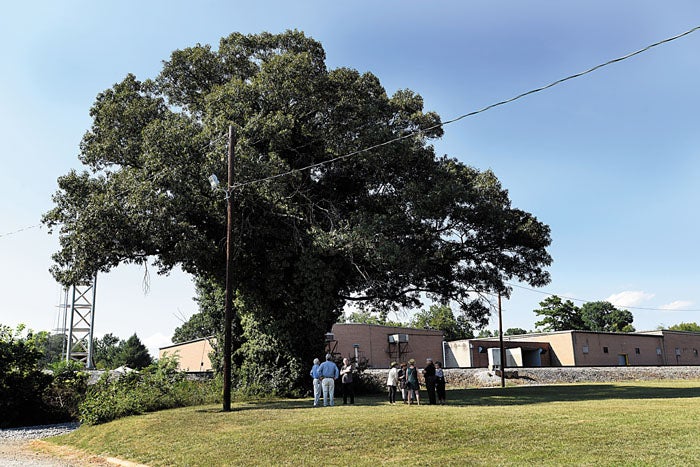Public Art Committee to hear presentation on marker commemorating lynchings in Jim Crow-era
Published 12:00 am Sunday, December 6, 2020

- The 2017 Service of Truth, Healing, and Reconciliation was held at North Long and Gillespie streets near the site of the lynchings in 1906. People speculated that this tree was the one on which the lynchings occured. Salisbury Post File Photo
By Natalie Anderson
natalie.anderson@salisburypost.com
SALISBURY — The Salisbury Public Art Committee on Monday will hear a presentation from Actions in Faith and Justice and the Equal Justice Initiative to discuss installing a historical marker downtown to recognize local Jim Crow-era lynchings as well as present-day racial injustice.
The Public Art Committee will meet via Zoom at 11:30 a.m. Locals can tune in by visiting us02web.zoom.us/j/82272371087 and entering meeting ID 822 7237 1087.
For more than three years, local grassroots organization Actions in Faith and Justice and local community members have worked with the Equal Justice Initiative to locate a fitting site with sufficient historical context to place a historic marker that recognizes local lynchings that occurred during the Jim Crow-era as well as acknowledges present-day racial injustice, said Actions in Faith and Justice Co-chair Susan Lee.
While an exact spot for the marker has not yet been determined, the presentation says an ideal location would be outside of Oak Grove-Freedman’s Cemetery, which currently pays homage to more than 150 mostly unknown African-American men, women and children buried there. More specifically, AFJ says it would like the marker to stand somewhere between the sidewalk and curb on Church Street, which is opposite the Oak Grove-Freedman’s Cemetery and across from the Rowan County Justice Center.
Initially, the desire was to place the marker inside of the Freedman’s Cemetery, but city staff expressed concern with land development ordinance guidelines for signs, particularly related to the height and pole type. For example, sign code for freestanding signs is based on road classification, so other locations may allow for different types and heights for signs. Additionally, the road classification will determine type of permit, which may be an uncommon sign permit.
Lee said AFJ has worked on putting this project since a 2017 commemoration event of the 1906 lynchings. The 1906 lynchings occurred when three Black men named Jack Dillingham, John Gillespie and son Nease Gillespie were abducted from the Rowan County jail in Salisbury and lynched by a white mob of more than 5,000 people in the vicinity of Henderson Park.
After the commemoration in 2017, the community focus shifted toward commemorating all lynchings known to have occurred in Rowan County and recognizing the fact that many unrecorded lynchings also occurred before and during the era of Jim Crow. A site installation committee has met periodically over the years to obtain local citizen feedback and suggestions for where the marker should be located, Lee said. The Freedman’s Cemetery location is seen as a parallel to honor the work of the people who are buried in the cemetery, as well as those who made the cemetery a memorial.
“This was the result of their work,” Lee said.
Kiara Boone, of the Equal Justice Initiative, will be present at Monday’s meeting. AFJ Co-chair Rev. Olen Bruner will also be present.
“Our work with Equal Justice Initiative is not simply to remember the past for the sake of the past,” Lee said. “But to remember the past for the sake of the future. We work toward future justice in the present moment.”
No formal action is expected for the project at the meeting.
“I just look forward to a continued discussion about this,” Lee said.
However, moving forward, working with the city on this project could allow a city board or commission to install the sign as a city applicant. If the sign is located within the city’s right-of-way, the installation will have to adhere to the city’s requirements for location, maintenance and liability, in addition to the North Carolina Department of Transportation if applicable.
On a black background with silver lettering, one side of the marker will commemorate local lynchings during the Jim Crow-era, not just the 1906 lynchings. The other side, which will be written by the Equal Justice Initiative, will provide broader historical context about the frequent occurrence of racial terror lynchings in the U.S. as Salisbury is only a “microcosm” of what happened across the nation, Lee said.
Also at the meeting, the committee will hear several updates related to financial, guidelines and History & Art Trial reports. Additionally, committee member Barbara Perry will provide information related to the Salisbury Sculpture Show.
Other business at the meeting will include discussions on a historical marker related to the Vietnam War and World War II, as well as the “Here is My Story” bench installation, which is one part of the Dixonville-Lincoln Memorial project. The second phase, set to be completed in December, will implement an interpretive walk and seating area, which will connect the Memorial Walk with interpretive stops along a perpendicular path to a high point in the cemetery.
Contact reporter Natalie Anderson at 704-797-4246.





